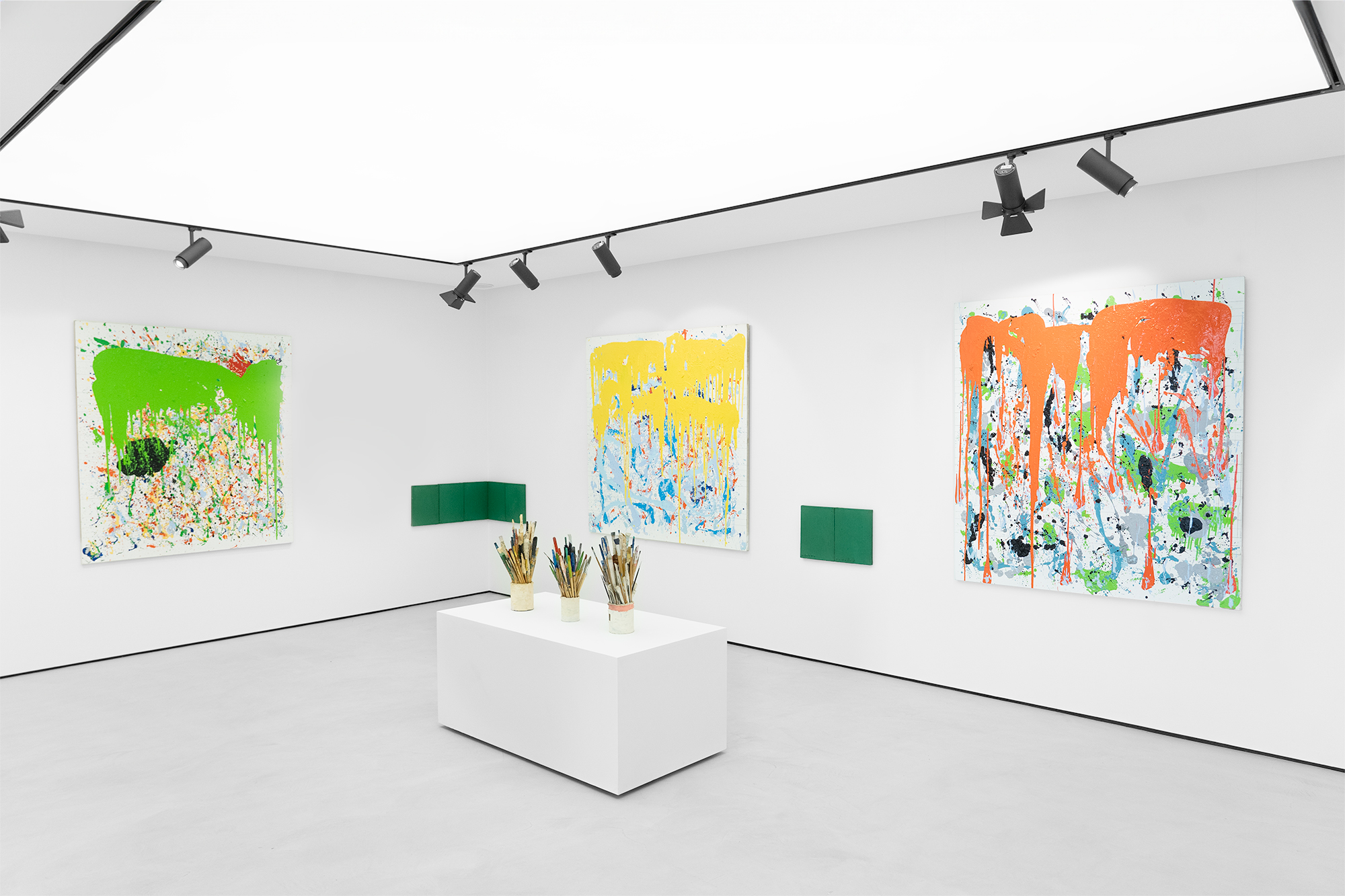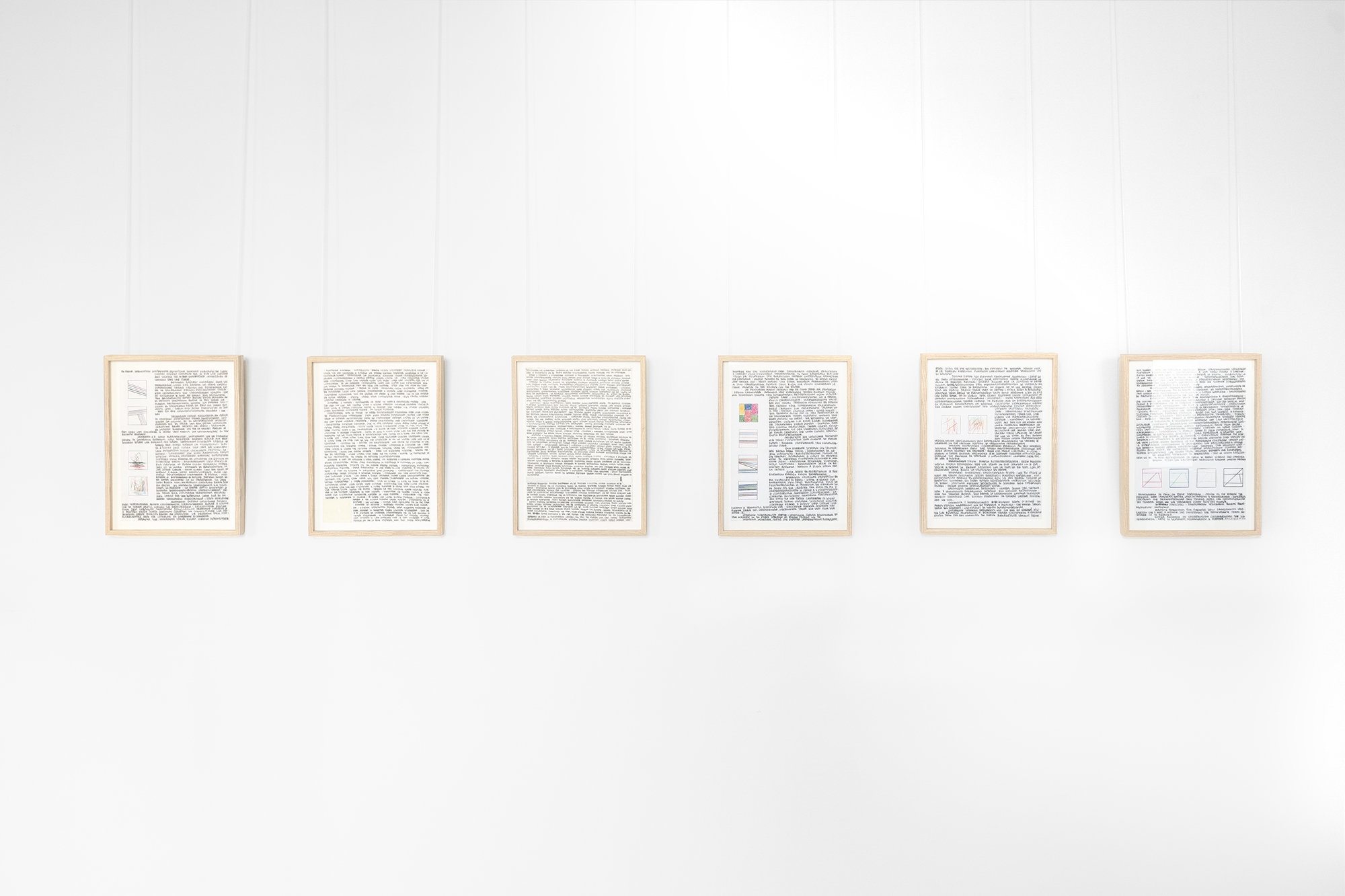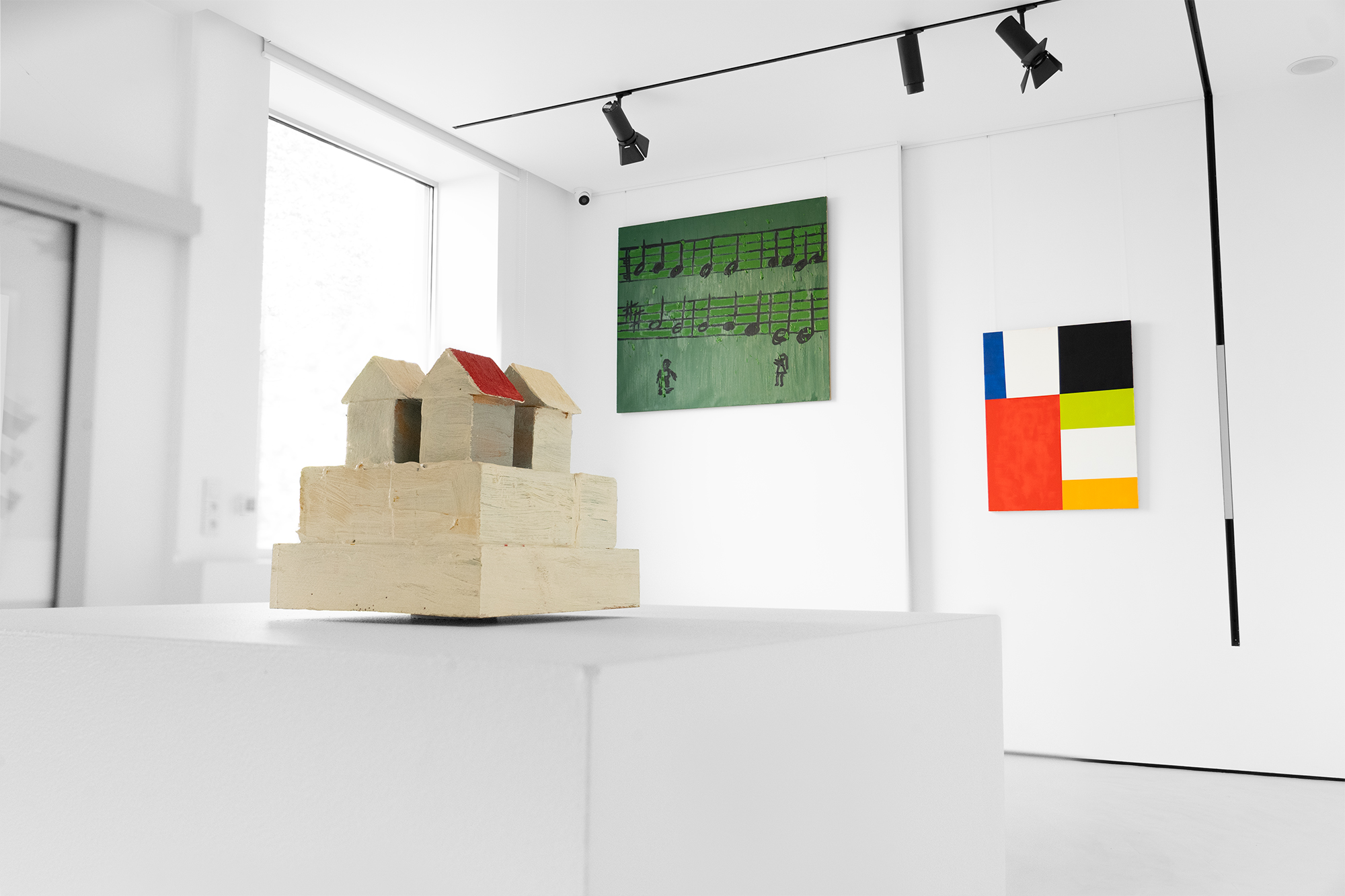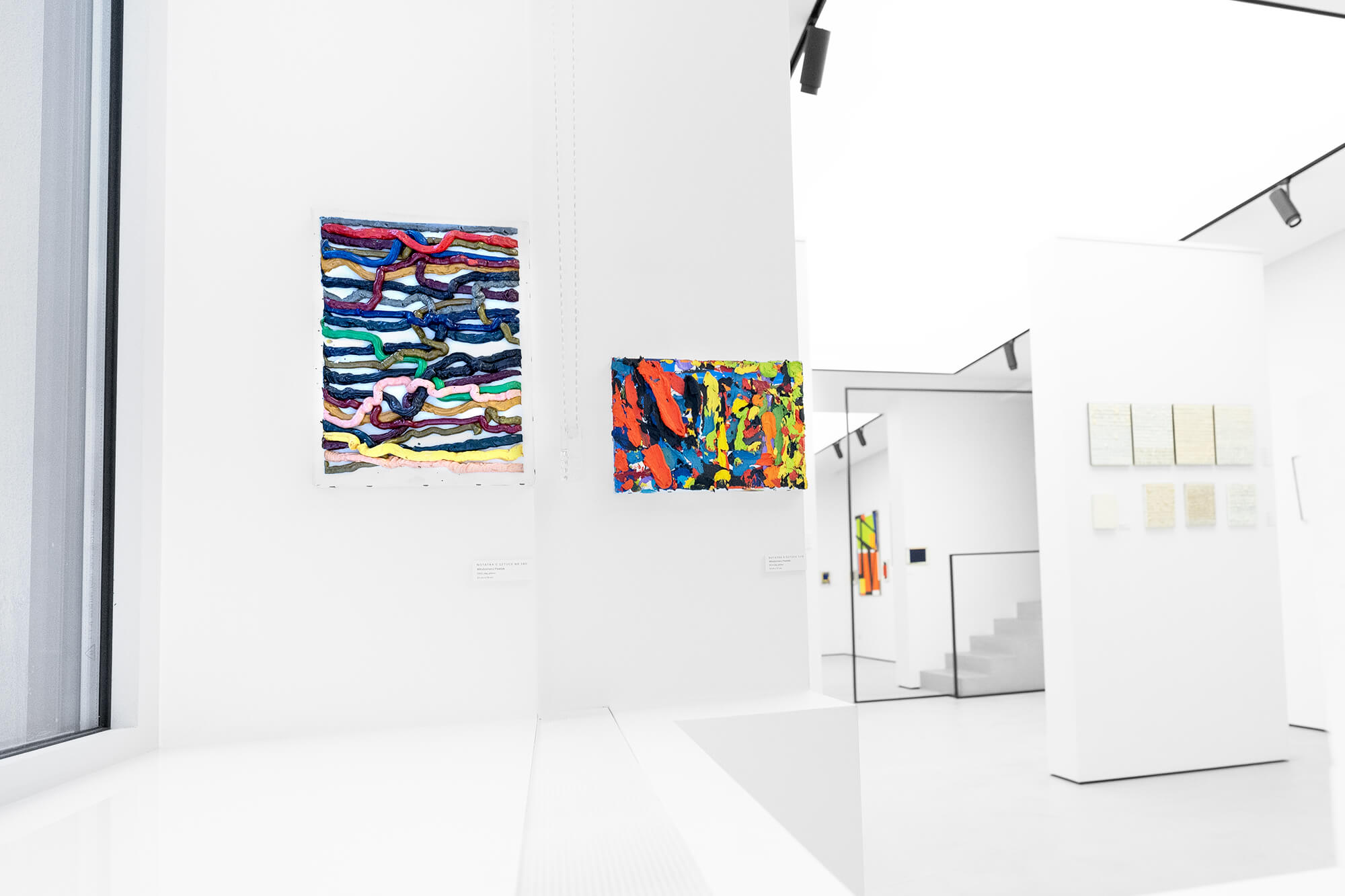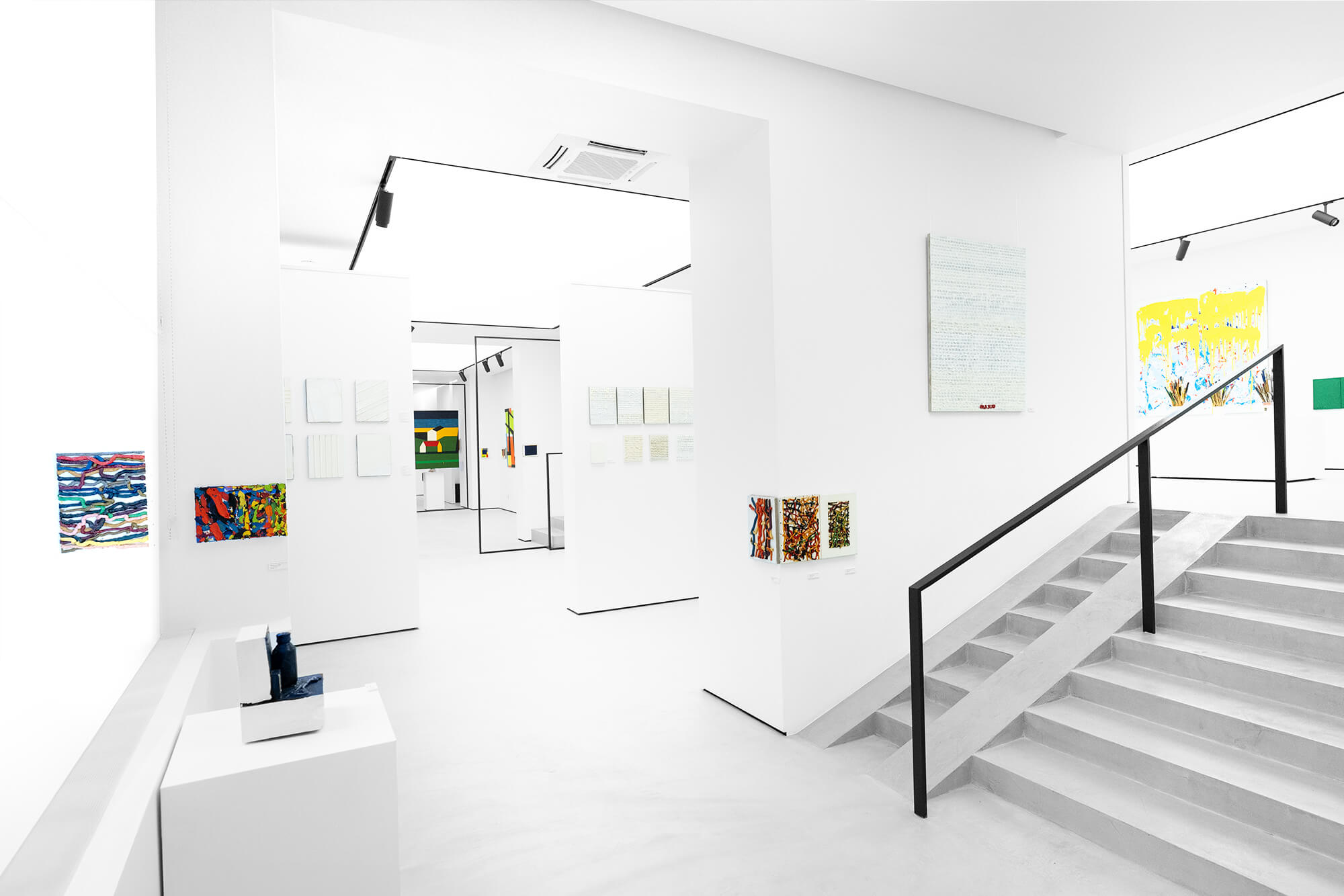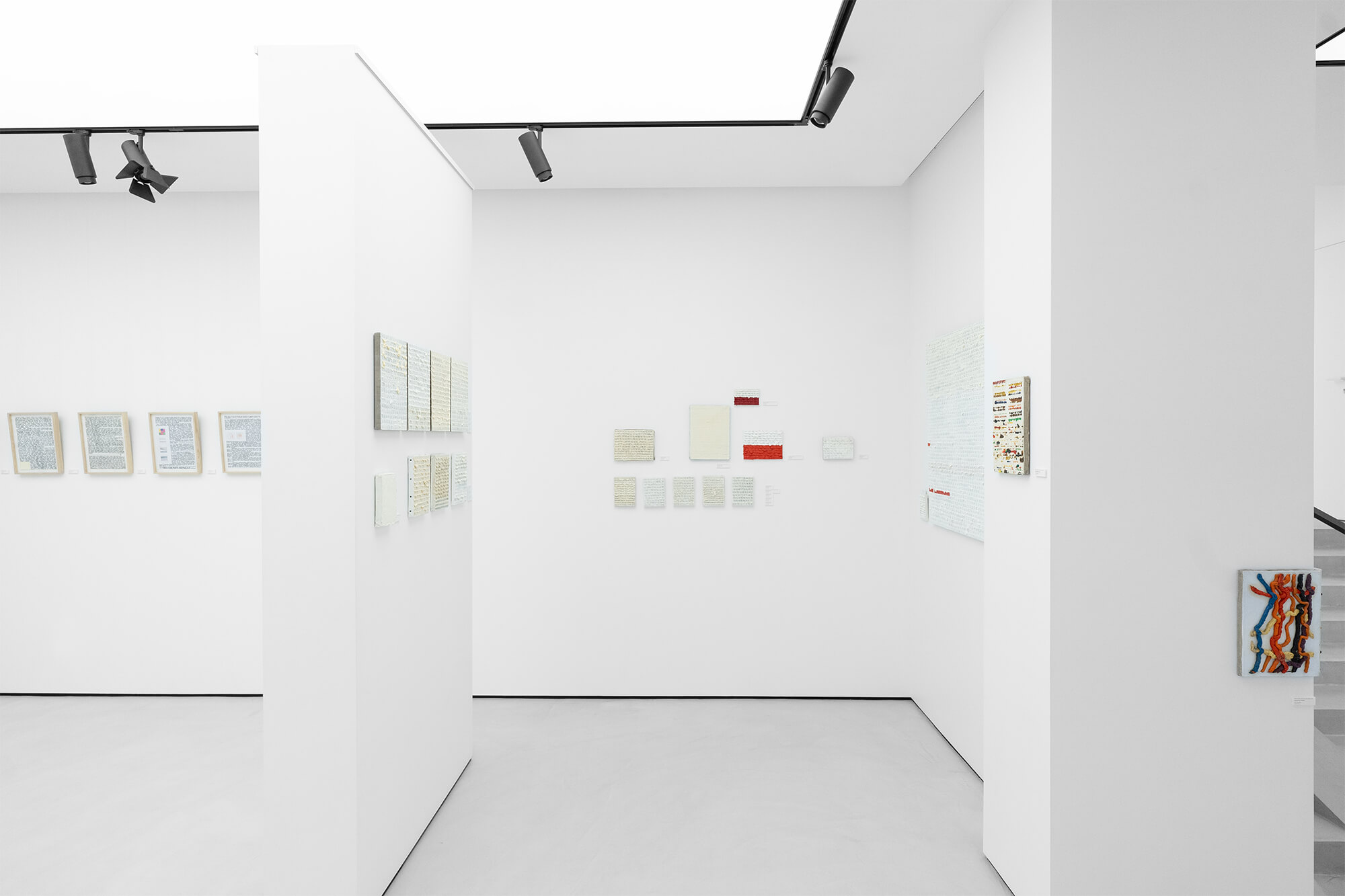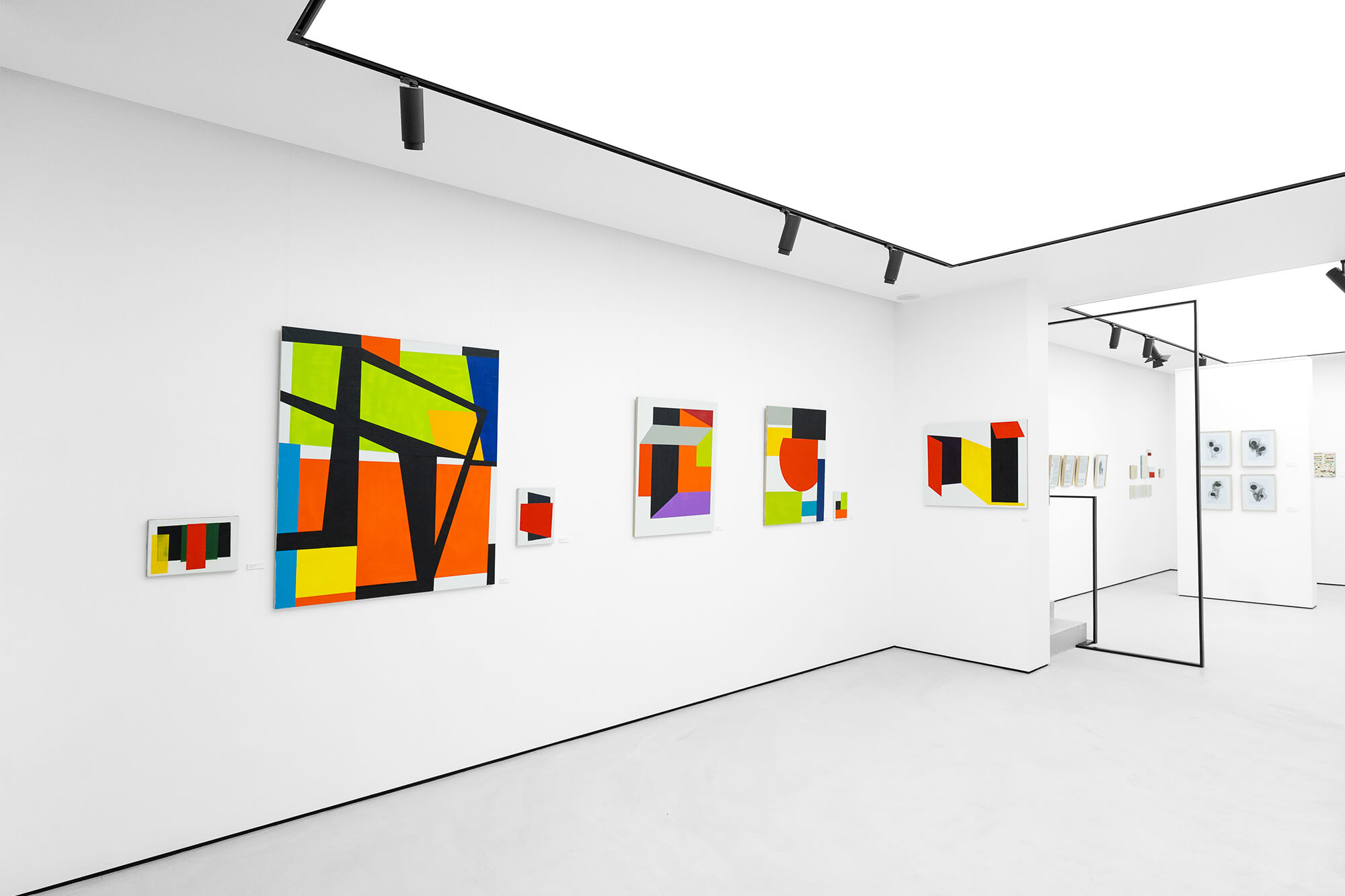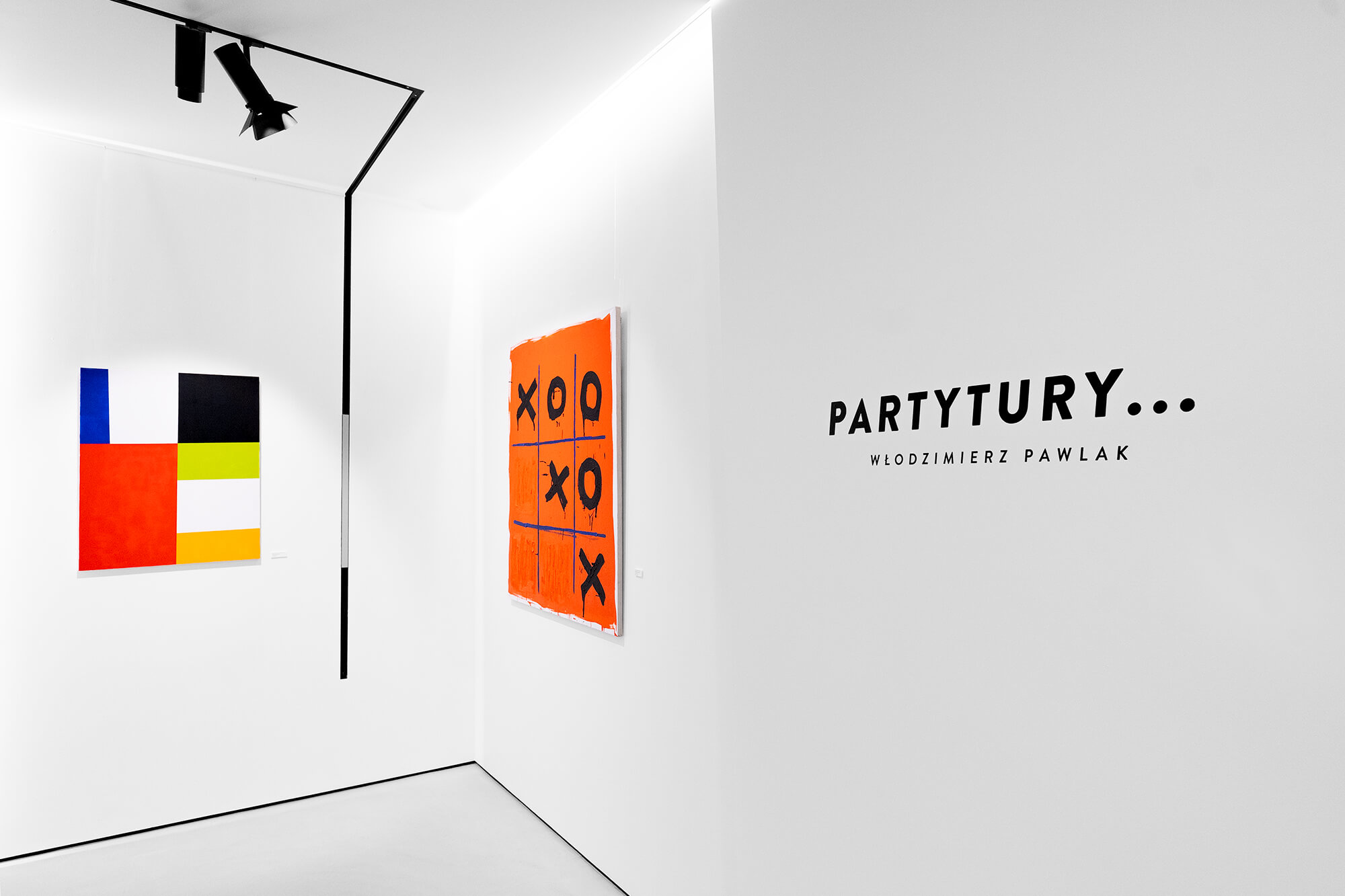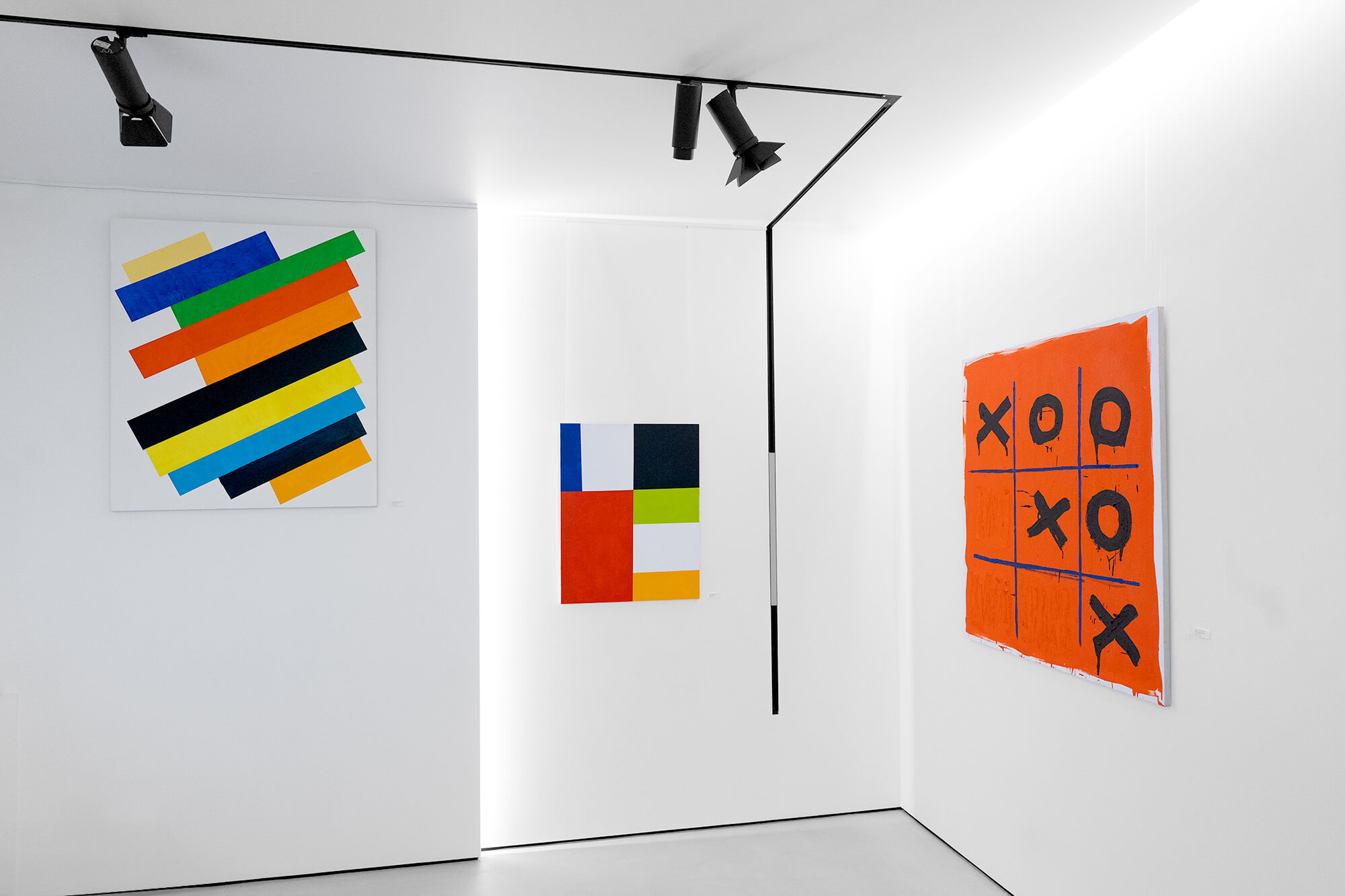Please wait while flipbook is loading. For more related info, FAQs and issues please refer to DearFlip WordPress Flipbook Plugin Help documentation.
Partytury…
czyli uwagi o dźwięczności farby w malarstwie Włodzimierza Pawlaka
Włodzimierz Pawlak to malarz-kompozytor, wyczulony na związki sztuki wizualnych i muzyki – stąd centralne miejsce na jego indywidualnej wystawie w galerii SZOKART zajmuje cykl obrazów zatytułowanych Partytura do baletu Sokrates, namalowany – jak dopowiadają podtytuły – wiosną, latem, jesienią i zimą 2023 roku.
W muzyce partytura to notacyjne zestawienie nad sobą wszystkich partii wokalnych i instrumentalnych utworu zespołowego, co ma na celu jak najbardziej przejrzyste utrwalenie całości dzieła. Partytura ma więc charakter wizualny, ponieważ eksponuje wertykalne związki między poszczególnymi partitami, zestawionymi nad sobą w pewnym określonym porządku. Podobnie malarski obraz – zgodnie z definicją Maurice’a Denisa z 1890 roku – jest płaską powierzchnią pokrytą kolorami w określonym porządku. Nic dziwnego zatem, że związki malarstwa i muzyki, znane od wielu stuleci, inspirują Pawlaka – artystę nieustannie poruszającego się pomiędzy tymi dwoma gatunkami.
Na wystawie w galerii SZOKART tytułowe Partytury… wiążą się jednak nie tylko z tą konkretną serią obrazów, lecz są również definiowane bardziej metaforycznie – odnoszą się bowiem do dzieł, które orkiestrują w sobie zarówno kolor, fakturalność i ekspresyjny malarski gest (m.in. prace z cyklów Dzienniki i Notatki o sztuce z farbami wyciskanymi bezpośrednio z tub na płaszczyznę), jak i do kompozycji traktowanych płasko i konstrukcyjnie, rozegranych geometrycznie (m.in. Notatki o sztuce, Dom, Linie barwne). Stąd w tytule wystawy wielokropek, który sugeruje, że chodzi o bardziej szerokie niż jedynie dosłowne, muzyczne rozumienie tego terminu.
Cykl Partytura do baletu Sokrates to cztery kwadratowe płótna 150×150 cm, na których pierwotnie Pawlak namalował pięciolinie. Następnie artysta naniósł na nie barwne plamy z dominantami w zieleni, żółci, czerwieni i bieli, konotujące odpowiednio nastroje i światło poszczególnych pór roku. Artysta wskazuje w ten sposób na czasowość, która jest immanentnie wpisana nie tylko w muzykę, lecz również w medium malarstwa. Rozchlapane ślady farby, wchodzące w dialog z techniką drippingu Jacksona Pollocka, układają się warstwowo i – niczym w partyturach muzycznych – wchodzą ze sobą we wzajemne związki niczym partity. Na koniec w każdej z kompozycji pojawia się najmocniejszy akord kolorystyczny, który rozlewa się dynamicznie i częściowo przykrywa pozostałe tony barwne, ściekając w dół – tak, jakby Pawlak pierwszą warstwę naniósł na obraz horyzontalnie, a ów ostatni akcent już w momencie, gdy płótno znalazło się w pozycji wertykalnej. W poszczególnych płótnach rozległe plamy wybrzmiewają forte, a może nawet fortissimo, zwłaszcza jeśli chodzi o wiosnę i lato. To pory roku malowane głośno i z rozmachem, w przeciwieństwie do wyciszonej i stonowanej zimy, którą słyszymy raczej piano. Jesień sytuuje się pomiędzy – jakby forte stopniowo przechodziło w akordy coraz cichsze. Czy to również interpretacja słynnego utworu Cztery pory roku Antonio Vivaldiego?
Dzięki podtytułom obrazów, nawiązującym do poszczególnych pór roku, możemy również wyobrażać sobie odgłosy związane z ich aurą: świergot ptaków, plusk wody w gorący dzień, subtelny wiatr strącający żółte i czerwone liście z drzew czy trzaskający mróz i chrzęst śniegu pod butami. Pawlak otwiera nam drogę do doznań synestezyjnych, w ramach których doświadczenia jednego zmysłu, w tym wypadku wzroku, wywołują doświadczenia charakterystyczne dla innych zmysłów – w duszy gra nam wszak cała symfonia.
Nie bez znaczenia jest w tym kontekście także figura Sokratesa, przywołana w tytułowej partyturze do utworu baletowego wykreowanego przez Pawlaka. Grecki filozof, oskarżony o wyznawanie niewłaściwych bogów i psucie młodzieży, nie tylko nie uciekł z więzienia, co wedle źródeł historycznych nie byłoby aż tak trudne, lecz wypił cykutę i umarł nieprzejednany. Cykl czterech obrazów to zatem swoisty hołd dla Sokratesa, który został wyrażony barwnymi partyturami malarskimi: od witalnej wiosennej zieleni, poprzez kulminację w letniej intensywnej, nasyconej słońcem żółci, aż po schyłek w dojrzałej jesiennej czerwieni i wyciszenie w zimowej bieli. Kompozycje te możemy więc postrzegać także jako rodzaj partytur egzystencjalnych, w których zapisany jest los autora słynnego zdania: „Wiem, że nic nie wiem”.
Biel, główny akord zimowego płótna, w dotychczasowej twórczości Pawlaka ma już swoje poczesne miejsce. Dominuje w Reliefie z 1994 roku, jest obecna w wielu pracach z cyklu Notatka o sztuce, w ramach którego pokazuje swoje różne odcienie i oblicza, a także kondensuje się w impastowe rytmicznie dystrybuowane lub ekspresyjnie kładzione konstelacje. W Dziennikach stanowi tło, często spiętrzając się fakturalnie i tworząc „nawisy” nad poszczególnymi linijkami, w których skreślane są kolejne jednostki czasu. Natomiast w Obrazie zamalowanym V, namalowanym zimą 2018 roku w Nieborowie bezpośrednio na Spacerze X (Jesień) z 2017 roku, powstałym w Radziejowicach, biel pokrywa wcześniejszą kompozycję niczym cienka warstwa śniegu, pozwalając nam częściowo odczytywać jej pierwotny wygląd. Jak podkreśla Dariusz Czaja: „Trudna jest ontologia bieli. Trudna, skomplikowana i daleka od jednoznaczności. Biel zadaje pytania, wtrąca w niepokój.” Bielą zajmowali się filozofowie i artyści, widząc w niej nieustające wyzwanie, tajemniczość i wiele sprzecznych cech. Pawlak sam wiele pisał o tym fenomenie: „Biel jest dobra i nie zaszkodzi malarstwu. (…) Biały obraz to zamiar dotarcia do tego, co nie zostało wypowiedziane.” Artysta komponuje ze sobą rozmaite akordy bieli w ramach jednego obrazu lub operuje tylko jednym jej rodzajem na powierzchni całego płótna, starając się zgłębić jej naturę od strony malarskiej praktyki. Te monochromatyczne dzieła – o jakże urozmaiconych fakturach i formatach – to malarskie partytury, odgrywające cały czas na nowo fundamentalne pytanie „czym jest obraz?”, puentowane sokratejskim „wiem, że nic nie wiem” w tle. To współpraca Pawlaka z białą farbą, która – wraz z pędzlami w puszkach wyeksponowanymi na wystawie jako obiekty – współtworzy kolejne warianty Notatek o sztuce, nieustannie drążąc temat malowania o malowaniu w obliczu upływającego czasu i bogactwa zmysłowych doznań, sprowadzonych do kompozycji minimalistycznych czy wręcz ascetycznych.
Syntezę rozgrywaną na zgoła innych zasadach prezentują z kolei pełne nasyconych kolorów płótna nawiązujące do nurtu abstrakcji geometrycznej, suprematyzmu Kazimierza Malewicza i m.in. cyklu Abstrakcji architektonicznych Władysława Strzemińskiego z lat 1926-1929. To zatem kolejne oblicze cyklu Notatka o sztuce. Pawlak przekłada w tych pracach doświadczenia brył, figur i przestrzeni na dwuwymiarowe układy, które zachowują przestrzenność, „żłobiąc” płaszczyznę obrazu w głąb i nadając jej iluzji głębi, powstającej dzięki oddziaływaniu barw ciepłych i zimnych. Artysta zanotował: „Widzenie sześcianu polega na widzeniu figury na płaszczyźnie oraz doznaniu głębi.”
Autor Partytur do baletu Sokrates gra więc malarski koncert, który zapisuje w każdej pojedynczej kompozycji z osobna i we wszystkich swoich płótnach w ogólności. Twórczość Pawlaka jest wszak jednocześnie harmonijna i pełna dysonansów, spójna i różnorodna, wybrzmiewa zarówno piano, jak i forte. Artysta o każdej porze roku z zapałem i niewygasającą ciekawością, buńczucznością, lecz i pokorą, staje przed sztalugą, by dociec tego, jak zapisać partyturę malarskiego arcydzieła i wydobyć dźwięczność z farby. Nie bez kozery Pawlak podkreśla: „Śledzenie mojej twórczości wymaga uwagi i wytrwałości. Tych, których na to stać, nie zawiodę.”
Marta Smolińska
Scores…
or: Some remarks on the sonority of the paint in the painting of Włodzimierz Pawlak
Włodzimierz Pawlak is a painter-composer with a special sensitivity to the bonds between the visual arts and music – hence central to his one-man show in the SZOKART Gallery is a series of paintings entitled Score for the ballet Socrates, painted, as the captions attest, in the spring, summer, autumn and winter of 2023.
In music, a score is the display of all the vocal and instrumental parts of a work one above the other, in the form of musical notation, for the purpose of recording the work in its entirety with maximum clarity. The score is thus visual in character, because it reveals the vertical connections between the individual parts, which are arranged in a particular descending order. Similarly, according to a definition coined by Maurice Denis in 1890, the painting is a flat surface covered with colours in a particular order. Unsurprisingly, then, it is the bonds between painting and music, which have been known for centuries, that provide Pawlak – an artist constantly operating between the two genres – with his inspiration.
In the exhibition at SZOKART, the title Scores… is not only a reference to the specific series of paintings mentioned above, but also encompasses a more metaphorical aspect: it references works that are an orchestration of colour, texture, and expressive painterly flair (including works from the series Diaries and Notes about Art in which the paints are squeezed directly from their tubes onto the support), as well as compositions that are treated more two-dimensionally and structurally, with a geometrical approach (others of the Notes on Art also fall into this category, as do House and Colourful Lines). Hence the ellipsis in the title of the exhibition, which suggests that this term is to be understood more broadly than merely in its literal, musical sense.
The cycle Score for the ballet Socrates comprises four 150×150 cm square canvases, onto which Pawlak first drew musical staves. Then he added daubs of colours with dominants of green, yellow, red, and white, suggesting the moods and light of the respective seasons of the year. In this way, he draws attention to temporality, which is an immanent element not only of music but also of the painting medium. The traces of splashed paint, which initiate dialogue with Jackson Pollock’s dripping technique, are applied in layers, and interact like the individual parts in musical scores. The final touch in each of these compositions is its strongest colour chord, which spreads dynamically, partly obliterating the other tones, running downwards – as if Pawlak had applied the first layer horizontally onto the canvas, and this final accent only once it was already in a vertical position. The spreading stains on each canvas resonate forte, even fortissimo, particularly on the spring and summer canvases. These two seasons are painted loudly and with flair, unlike the subtler, muted winter, which we hear rather more piano. Autumn is somewhere in between, as if the forte were gradually fading into quieter and quieter chords. Is this also an interpretation of the famous Four Seasons by Vivaldi?
The seasons referenced in the subtitles of the paintings help us to go further and imagine the sounds associated with them: birdsong, the splash of water on a hot day, a light breeze coaxing the red and yellow leaves from the trees, or a sharp frost and the crunch of snow under our boots. Pawlak opens us up a way into synaesthetic experiences which, through the stimuli received by one sense, in this case sight, produce sensations characteristic for other senses – our souls compose entire symphonies.
The figure of Socrates mentioned in the title score for the ballet written by Pawlak is also significant in this context. Charged with venerating false gods and depraving youth, the Greek philosopher not only did not escape from prison, which according to historical sources would not have been particularly difficult, but drank hemlock and died intransigent. The cycle of four paintings, then, is a form of homage to him, paid in brightly painted scores: from the vibrant spring green through the culminating intensity and saturation of the yellow sun of summer, to the descent into mature autumn red and the calm of winter white. These compositions may in this respect also be read as a kind of existential score notating the fate of the man who articulated the famous words: ‘The only true wisdom is in knowing you know nothing.’
White, which forms the main chord in the winter canvas, already has an established place in Pawlak’s oeuvre. It is the dominant in Relief of 1994, and is present in many of the works in the cycle Notes on Art, in which it shows off its many shades and faces, and condenses in the rhythmically distributed or expressively applied impasto constellations. In Diaries it forms a background, often building texture and forming ‘overhangs’ above the lines into which the successive units of time are inscribed. In Painted Painting V, painted in the winter of 2018 in Nieborów directly onto Walk X (Autumn) of 2017, which had been made in Radziejowice, the white veils the earlier composition like a light covering of snow, allowing us to partly decipher its original appearance. As Dariusz Czaja stresses: ‘The ontology of white is difficult. Difficult, complicated, and far from explicit. White poses questions, casts into doubt.’ White has been studied by philosophers and artists, who have seen in it a constant challenge, mysteriousness, and many other contradictory qualities. Pawlak himself has written a great deal on this phenomenon: ‘White is good, and will not do painting any detriment. (…) A white painting is the intention to penetrate to what has not been articulated.’ He juxtaposes various chords of white in one painting, or uses only one type on the whole canvas, in an attempt to plumb its nature from the angle of his painting practice. These monochromatic works, so varied in texture and format, are painted scores, untiringly replaying the fundamental question: ‘What is a painting?’, with the Socratic motto ‘I know that I know nothing’ echoing in the background. This is Pawlak’s collaboration with white paint, which – together with the paintbrushes in pots also on display in the exhibition – has produced successive variants of Notes on Art, constantly pursuing the theme of painting about painting faced with the passage of time and the richness of sensory experience reduced to minimalistic, even ascetic compositions.
An entirely different face of the cycle Notes on Art, representing a synthesis enacted on the basis of other principles altogether, is shown by the colour-saturated canvases referencing geometric abstraction and the suprematism of Kazimir Malevich and works including Władysław Strzemiński’s Architectural Compositions of 1926–1929. In these works, Pawlak transposes his experiences of solid shapes, figures, and spaces into two-dimensional arrangements, which nonetheless retain their three-dimensional character, ‘digging down’ into the surface of the painting and lending it the illusion of depth through the interaction of warm and cold colours. He notes: ‘Seeing a cuboid is a matter of seeing a figure on a flat plane and experiencing depth.’
The author of Scores for the ballet Socrates is thus performing a concert in painting, recorded in the form of each individual composition separately and all his canvases collectively. Pawlak’s oeuvre is at once harmonious and packed with dissonances, cohesive and diverse, both piano and forte. He stands before his easel in every season with energy and an insatiable curiosity, with a certain bravado, but also with humility, to figure out how to write a score for a painting masterpiece and produce sonority from paint. He stresses, not without reason: ‘It takes concentration and determination to follow my work. I will not disappoint those who invest that effort.’
Marta Smolińska
Partytury…
czyli uwagi o dźwięczności farby w malarstwie Włodzimierza Pawlaka
Włodzimierz Pawlak to malarz-kompozytor, wyczulony na związki sztuki wizualnych i muzyki – stąd centralne miejsce na jego indywidualnej wystawie w galerii SZOKART zajmuje cykl obrazów zatytułowanych Partytura do baletu Sokrates, namalowany – jak dopowiadają podtytuły – wiosną, latem, jesienią i zimą 2023 roku.
W muzyce partytura to notacyjne zestawienie nad sobą wszystkich partii wokalnych i instrumentalnych utworu zespołowego, co ma na celu jak najbardziej przejrzyste utrwalenie całości dzieła. Partytura ma więc charakter wizualny, ponieważ eksponuje wertykalne związki między poszczególnymi partitami, zestawionymi nad sobą w pewnym określonym porządku. Podobnie malarski obraz – zgodnie z definicją Maurice’a Denisa z 1890 roku – jest płaską powierzchnią pokrytą kolorami w określonym porządku. Nic dziwnego zatem, że związki malarstwa i muzyki, znane od wielu stuleci, inspirują Pawlaka – artystę nieustannie poruszającego się pomiędzy tymi dwoma gatunkami.
Na wystawie w galerii SZOKART tytułowe Partytury… wiążą się jednak nie tylko z tą konkretną serią obrazów, lecz są również definiowane bardziej metaforycznie – odnoszą się bowiem do dzieł, które orkiestrują w sobie zarówno kolor, fakturalność i ekspresyjny malarski gest (m.in. prace z cyklów Dzienniki i Notatki o sztuce z farbami wyciskanymi bezpośrednio z tub na płaszczyznę), jak i do kompozycji traktowanych płasko i konstrukcyjnie, rozegranych geometrycznie (m.in. Notatki o sztuce, Dom, Linie barwne). Stąd w tytule wystawy wielokropek, który sugeruje, że chodzi o bardziej szerokie niż jedynie dosłowne, muzyczne rozumienie tego terminu.
Cykl Partytura do baletu Sokrates to cztery kwadratowe płótna 150×150 cm, na których pierwotnie Pawlak namalował pięciolinie. Następnie artysta naniósł na nie barwne plamy z dominantami w zieleni, żółci, czerwieni i bieli, konotujące odpowiednio nastroje i światło poszczególnych pór roku. Artysta wskazuje w ten sposób na czasowość, która jest immanentnie wpisana nie tylko w muzykę, lecz również w medium malarstwa. Rozchlapane ślady farby, wchodzące w dialog z techniką drippingu Jacksona Pollocka, układają się warstwowo i – niczym w partyturach muzycznych – wchodzą ze sobą we wzajemne związki niczym partity. Na koniec w każdej z kompozycji pojawia się najmocniejszy akord kolorystyczny, który rozlewa się dynamicznie i częściowo przykrywa pozostałe tony barwne, ściekając w dół – tak, jakby Pawlak pierwszą warstwę naniósł na obraz horyzontalnie, a ów ostatni akcent już w momencie, gdy płótno znalazło się w pozycji wertykalnej. W poszczególnych płótnach rozległe plamy wybrzmiewają forte, a może nawet fortissimo, zwłaszcza jeśli chodzi o wiosnę i lato. To pory roku malowane głośno i z rozmachem, w przeciwieństwie do wyciszonej i stonowanej zimy, którą słyszymy raczej piano. Jesień sytuuje się pomiędzy – jakby forte stopniowo przechodziło w akordy coraz cichsze. Czy to również interpretacja słynnego utworu Cztery pory roku Antonio Vivaldiego?
Dzięki podtytułom obrazów, nawiązującym do poszczególnych pór roku, możemy również wyobrażać sobie odgłosy związane z ich aurą: świergot ptaków, plusk wody w gorący dzień, subtelny wiatr strącający żółte i czerwone liście z drzew czy trzaskający mróz i chrzęst śniegu pod butami. Pawlak otwiera nam drogę do doznań synestezyjnych, w ramach których doświadczenia jednego zmysłu, w tym wypadku wzroku, wywołują doświadczenia charakterystyczne dla innych zmysłów – w duszy gra nam wszak cała symfonia.
Nie bez znaczenia jest w tym kontekście także figura Sokratesa, przywołana w tytułowej partyturze do utworu baletowego wykreowanego przez Pawlaka. Grecki filozof, oskarżony o wyznawanie niewłaściwych bogów i psucie młodzieży, nie tylko nie uciekł z więzienia, co wedle źródeł historycznych nie byłoby aż tak trudne, lecz wypił cykutę i umarł nieprzejednany. Cykl czterech obrazów to zatem swoisty hołd dla Sokratesa, który został wyrażony barwnymi partyturami malarskimi: od witalnej wiosennej zieleni, poprzez kulminację w letniej intensywnej, nasyconej słońcem żółci, aż po schyłek w dojrzałej jesiennej czerwieni i wyciszenie w zimowej bieli. Kompozycje te możemy więc postrzegać także jako rodzaj partytur egzystencjalnych, w których zapisany jest los autora słynnego zdania: „Wiem, że nic nie wiem”.
Biel, główny akord zimowego płótna, w dotychczasowej twórczości Pawlaka ma już swoje poczesne miejsce. Dominuje w Reliefie z 1994 roku, jest obecna w wielu pracach z cyklu Notatka o sztuce, w ramach którego pokazuje swoje różne odcienie i oblicza, a także kondensuje się w impastowe rytmicznie dystrybuowane lub ekspresyjnie kładzione konstelacje. W Dziennikach stanowi tło, często spiętrzając się fakturalnie i tworząc „nawisy” nad poszczególnymi linijkami, w których skreślane są kolejne jednostki czasu. Natomiast w Obrazie zamalowanym V, namalowanym zimą 2018 roku w Nieborowie bezpośrednio na Spacerze X (Jesień) z 2017 roku, powstałym w Radziejowicach, biel pokrywa wcześniejszą kompozycję niczym cienka warstwa śniegu, pozwalając nam częściowo odczytywać jej pierwotny wygląd. Jak podkreśla Dariusz Czaja: „Trudna jest ontologia bieli. Trudna, skomplikowana i daleka od jednoznaczności. Biel zadaje pytania, wtrąca w niepokój.” Bielą zajmowali się filozofowie i artyści, widząc w niej nieustające wyzwanie, tajemniczość i wiele sprzecznych cech. Pawlak sam wiele pisał o tym fenomenie: „Biel jest dobra i nie zaszkodzi malarstwu. (…) Biały obraz to zamiar dotarcia do tego, co nie zostało wypowiedziane.” Artysta komponuje ze sobą rozmaite akordy bieli w ramach jednego obrazu lub operuje tylko jednym jej rodzajem na powierzchni całego płótna, starając się zgłębić jej naturę od strony malarskiej praktyki. Te monochromatyczne dzieła – o jakże urozmaiconych fakturach i formatach – to malarskie partytury, odgrywające cały czas na nowo fundamentalne pytanie „czym jest obraz?”, puentowane sokratejskim „wiem, że nic nie wiem” w tle. To współpraca Pawlaka z białą farbą, która – wraz z pędzlami w puszkach wyeksponowanymi na wystawie jako obiekty – współtworzy kolejne warianty Notatek o sztuce, nieustannie drążąc temat malowania o malowaniu w obliczu upływającego czasu i bogactwa zmysłowych doznań, sprowadzonych do kompozycji minimalistycznych czy wręcz ascetycznych.
Syntezę rozgrywaną na zgoła innych zasadach prezentują z kolei pełne nasyconych kolorów płótna nawiązujące do nurtu abstrakcji geometrycznej, suprematyzmu Kazimierza Malewicza i m.in. cyklu Abstrakcji architektonicznych Władysława Strzemińskiego z lat 1926-1929. To zatem kolejne oblicze cyklu Notatka o sztuce. Pawlak przekłada w tych pracach doświadczenia brył, figur i przestrzeni na dwuwymiarowe układy, które zachowują przestrzenność, „żłobiąc” płaszczyznę obrazu w głąb i nadając jej iluzji głębi, powstającej dzięki oddziaływaniu barw ciepłych i zimnych. Artysta zanotował: „Widzenie sześcianu polega na widzeniu figury na płaszczyźnie oraz doznaniu głębi.”
Autor Partytur do baletu Sokrates gra więc malarski koncert, który zapisuje w każdej pojedynczej kompozycji z osobna i we wszystkich swoich płótnach w ogólności. Twórczość Pawlaka jest wszak jednocześnie harmonijna i pełna dysonansów, spójna i różnorodna, wybrzmiewa zarówno piano, jak i forte. Artysta o każdej porze roku z zapałem i niewygasającą ciekawością, buńczucznością, lecz i pokorą, staje przed sztalugą, by dociec tego, jak zapisać partyturę malarskiego arcydzieła i wydobyć dźwięczność z farby. Nie bez kozery Pawlak podkreśla: „Śledzenie mojej twórczości wymaga uwagi i wytrwałości. Tych, których na to stać, nie zawiodę.”
Marta Smolińska
Scores…
or: Some remarks on the sonority of the paint in the painting of Włodzimierz Pawlak
Włodzimierz Pawlak is a painter-composer with a special sensitivity to the bonds between the visual arts and music – hence central to his one-man show in the SZOKART Gallery is a series of paintings entitled Score for the ballet Socrates, painted, as the captions attest, in the spring, summer, autumn and winter of 2023.
In music, a score is the display of all the vocal and instrumental parts of a work one above the other, in the form of musical notation, for the purpose of recording the work in its entirety with maximum clarity. The score is thus visual in character, because it reveals the vertical connections between the individual parts, which are arranged in a particular descending order. Similarly, according to a definition coined by Maurice Denis in 1890, the painting is a flat surface covered with colours in a particular order. Unsurprisingly, then, it is the bonds between painting and music, which have been known for centuries, that provide Pawlak – an artist constantly operating between the two genres – with his inspiration.
In the exhibition at SZOKART, the title Scores… is not only a reference to the specific series of paintings mentioned above, but also encompasses a more metaphorical aspect: it references works that are an orchestration of colour, texture, and expressive painterly flair (including works from the series Diaries and Notes about Art in which the paints are squeezed directly from their tubes onto the support), as well as compositions that are treated more two-dimensionally and structurally, with a geometrical approach (others of the Notes on Art also fall into this category, as do House and Colourful Lines). Hence the ellipsis in the title of the exhibition, which suggests that this term is to be understood more broadly than merely in its literal, musical sense.
The cycle Score for the ballet Socrates comprises four 150×150 cm square canvases, onto which Pawlak first drew musical staves. Then he added daubs of colours with dominants of green, yellow, red, and white, suggesting the moods and light of the respective seasons of the year. In this way, he draws attention to temporality, which is an immanent element not only of music but also of the painting medium. The traces of splashed paint, which initiate dialogue with Jackson Pollock’s dripping technique, are applied in layers, and interact like the individual parts in musical scores. The final touch in each of these compositions is its strongest colour chord, which spreads dynamically, partly obliterating the other tones, running downwards – as if Pawlak had applied the first layer horizontally onto the canvas, and this final accent only once it was already in a vertical position. The spreading stains on each canvas resonate forte, even fortissimo, particularly on the spring and summer canvases. These two seasons are painted loudly and with flair, unlike the subtler, muted winter, which we hear rather more piano. Autumn is somewhere in between, as if the forte were gradually fading into quieter and quieter chords. Is this also an interpretation of the famous Four Seasons by Vivaldi?
The seasons referenced in the subtitles of the paintings help us to go further and imagine the sounds associated with them: birdsong, the splash of water on a hot day, a light breeze coaxing the red and yellow leaves from the trees, or a sharp frost and the crunch of snow under our boots. Pawlak opens us up a way into synaesthetic experiences which, through the stimuli received by one sense, in this case sight, produce sensations characteristic for other senses – our souls compose entire symphonies.
The figure of Socrates mentioned in the title score for the ballet written by Pawlak is also significant in this context. Charged with venerating false gods and depraving youth, the Greek philosopher not only did not escape from prison, which according to historical sources would not have been particularly difficult, but drank hemlock and died intransigent. The cycle of four paintings, then, is a form of homage to him, paid in brightly painted scores: from the vibrant spring green through the culminating intensity and saturation of the yellow sun of summer, to the descent into mature autumn red and the calm of winter white. These compositions may in this respect also be read as a kind of existential score notating the fate of the man who articulated the famous words: ‘The only true wisdom is in knowing you know nothing.’
White, which forms the main chord in the winter canvas, already has an established place in Pawlak’s oeuvre. It is the dominant in Relief of 1994, and is present in many of the works in the cycle Notes on Art, in which it shows off its many shades and faces, and condenses in the rhythmically distributed or expressively applied impasto constellations. In Diaries it forms a background, often building texture and forming ‘overhangs’ above the lines into which the successive units of time are inscribed. In Painted Painting V, painted in the winter of 2018 in Nieborów directly onto Walk X (Autumn) of 2017, which had been made in Radziejowice, the white veils the earlier composition like a light covering of snow, allowing us to partly decipher its original appearance. As Dariusz Czaja stresses: ‘The ontology of white is difficult. Difficult, complicated, and far from explicit. White poses questions, casts into doubt.’ White has been studied by philosophers and artists, who have seen in it a constant challenge, mysteriousness, and many other contradictory qualities. Pawlak himself has written a great deal on this phenomenon: ‘White is good, and will not do painting any detriment. (…) A white painting is the intention to penetrate to what has not been articulated.’ He juxtaposes various chords of white in one painting, or uses only one type on the whole canvas, in an attempt to plumb its nature from the angle of his painting practice. These monochromatic works, so varied in texture and format, are painted scores, untiringly replaying the fundamental question: ‘What is a painting?’, with the Socratic motto ‘I know that I know nothing’ echoing in the background. This is Pawlak’s collaboration with white paint, which – together with the paintbrushes in pots also on display in the exhibition – has produced successive variants of Notes on Art, constantly pursuing the theme of painting about painting faced with the passage of time and the richness of sensory experience reduced to minimalistic, even ascetic compositions.
An entirely different face of the cycle Notes on Art, representing a synthesis enacted on the basis of other principles altogether, is shown by the colour-saturated canvases referencing geometric abstraction and the suprematism of Kazimir Malevich and works including Władysław Strzemiński’s Architectural Compositions of 1926–1929. In these works, Pawlak transposes his experiences of solid shapes, figures, and spaces into two-dimensional arrangements, which nonetheless retain their three-dimensional character, ‘digging down’ into the surface of the painting and lending it the illusion of depth through the interaction of warm and cold colours. He notes: ‘Seeing a cuboid is a matter of seeing a figure on a flat plane and experiencing depth.’
The author of Scores for the ballet Socrates is thus performing a concert in painting, recorded in the form of each individual composition separately and all his canvases collectively. Pawlak’s oeuvre is at once harmonious and packed with dissonances, cohesive and diverse, both piano and forte. He stands before his easel in every season with energy and an insatiable curiosity, with a certain bravado, but also with humility, to figure out how to write a score for a painting masterpiece and produce sonority from paint. He stresses, not without reason: ‘It takes concentration and determination to follow my work. I will not disappoint those who invest that effort.’
Marta Smolińska
ENG.
Scores…
or: Some remarks on the sonority of the paint in the painting of Włodzimierz Pawlak
Włodzimierz Pawlak is a painter-composer with a special sensitivity to the bonds between the visual arts and music – hence central to his one-man show in the SZOKART Gallery is a series of paintings entitled Score for the ballet Socrates, painted, as the captions attest, in the spring, summer, autumn and winter of 2023.
In music, a score is the display of all the vocal and instrumental parts of a work one above the other, in the form of musical notation, for the purpose of recording the work in its entirety with maximum clarity. The score is thus visual in character, because it reveals the vertical connections between the individual parts, which are arranged in a particular descending order. Similarly, according to a definition coined by Maurice Denis in 1890, the painting is a flat surface covered with colours in a particular order. Unsurprisingly, then, it is the bonds between painting and music, which have been known for centuries, that provide Pawlak – an artist constantly operating between the two genres – with his inspiration.
In the exhibition at SZOKART, the title Scores… is not only a reference to the specific series of paintings mentioned above, but also encompasses a more metaphorical aspect: it references works that are an orchestration of colour, texture, and expressive painterly flair (including works from the series Diaries and Notes about Art in which the paints are squeezed directly from their tubes onto the support), as well as compositions that are treated more two-dimensionally and structurally, with a geometrical approach (others of the Notes on Art also fall into this category, as do House and Colourful Lines). Hence the ellipsis in the title of the exhibition, which suggests that this term is to be understood more broadly than merely in its literal, musical sense.
The cycle Score for the ballet Socrates comprises four 150×150 cm square canvases, onto which Pawlak first drew musical staves. Then he added daubs of colours with dominants of green, yellow, red, and white, suggesting the moods and light of the respective seasons of the year. In this way, he draws attention to temporality, which is an immanent element not only of music but also of the painting medium. The traces of splashed paint, which initiate dialogue with Jackson Pollock’s dripping technique, are applied in layers, and interact like the individual parts in musical scores. The final touch in each of these compositions is its strongest colour chord, which spreads dynamically, partly obliterating the other tones, running downwards – as if Pawlak had applied the first layer horizontally onto the canvas, and this final accent only once it was already in a vertical position. The spreading stains on each canvas resonate forte, even fortissimo, particularly on the spring and summer canvases. These two seasons are painted loudly and with flair, unlike the subtler, muted winter, which we hear rather more piano. Autumn is somewhere in between, as if the forte were gradually fading into quieter and quieter chords. Is this also an interpretation of the famous Four Seasons by Vivaldi?
The seasons referenced in the subtitles of the paintings help us to go further and imagine the sounds associated with them: birdsong, the splash of water on a hot day, a light breeze coaxing the red and yellow leaves from the trees, or a sharp frost and the crunch of snow under our boots. Pawlak opens us up a way into synaesthetic experiences which, through the stimuli received by one sense, in this case sight, produce sensations characteristic for other senses – our souls compose entire symphonies.
The figure of Socrates mentioned in the title score for the ballet written by Pawlak is also significant in this context. Charged with venerating false gods and depraving youth, the Greek philosopher not only did not escape from prison, which according to historical sources would not have been particularly difficult, but drank hemlock and died intransigent. The cycle of four paintings, then, is a form of homage to him, paid in brightly painted scores: from the vibrant spring green through the culminating intensity and saturation of the yellow sun of summer, to the descent into mature autumn red and the calm of winter white. These compositions may in this respect also be read as a kind of existential score notating the fate of the man who articulated the famous words: ‘The only true wisdom is in knowing you know nothing.’
White, which forms the main chord in the winter canvas, already has an established place in Pawlak’s oeuvre. It is the dominant in Relief of 1994, and is present in many of the works in the cycle Notes on Art, in which it shows off its many shades and faces, and condenses in the rhythmically distributed or expressively applied impasto constellations. In Diaries it forms a background, often building texture and forming ‘overhangs’ above the lines into which the successive units of time are inscribed. In Painted Painting V, painted in the winter of 2018 in Nieborów directly onto Walk X (Autumn) of 2017, which had been made in Radziejowice, the white veils the earlier composition like a light covering of snow, allowing us to partly decipher its original appearance. As Dariusz Czaja stresses: ‘The ontology of white is difficult. Difficult, complicated, and far from explicit. White poses questions, casts into doubt.’ White has been studied by philosophers and artists, who have seen in it a constant challenge, mysteriousness, and many other contradictory qualities. Pawlak himself has written a great deal on this phenomenon: ‘White is good, and will not do painting any detriment. (…) A white painting is the intention to penetrate to what has not been articulated.’ He juxtaposes various chords of white in one painting, or uses only one type on the whole canvas, in an attempt to plumb its nature from the angle of his painting practice. These monochromatic works, so varied in texture and format, are painted scores, untiringly replaying the fundamental question: ‘What is a painting?’, with the Socratic motto ‘I know that I know nothing’ echoing in the background. This is Pawlak’s collaboration with white paint, which – together with the paintbrushes in pots also on display in the exhibition – has produced successive variants of Notes on Art, constantly pursuing the theme of painting about painting faced with the passage of time and the richness of sensory experience reduced to minimalistic, even ascetic compositions.
An entirely different face of the cycle Notes on Art, representing a synthesis enacted on the basis of other principles altogether, is shown by the colour-saturated canvases referencing geometric abstraction and the suprematism of Kazimir Malevich and works including Władysław Strzemiński’s Architectural Compositions of 1926–1929. In these works, Pawlak transposes his experiences of solid shapes, figures, and spaces into two-dimensional arrangements, which nonetheless retain their three-dimensional character, ‘digging down’ into the surface of the painting and lending it the illusion of depth through the interaction of warm and cold colours. He notes: ‘Seeing a cuboid is a matter of seeing a figure on a flat plane and experiencing depth.’
The author of Scores for the ballet Socrates is thus performing a concert in painting, recorded in the form of each individual composition separately and all his canvases collectively. Pawlak’s oeuvre is at once harmonious and packed with dissonances, cohesive and diverse, both piano and forte. He stands before his easel in every season with energy and an insatiable curiosity, with a certain bravado, but also with humility, to figure out how to write a score for a painting masterpiece and produce sonority from paint. He stresses, not without reason: ‘It takes concentration and determination to follow my work. I will not disappoint those who invest that effort.’
Marta Smolińska

